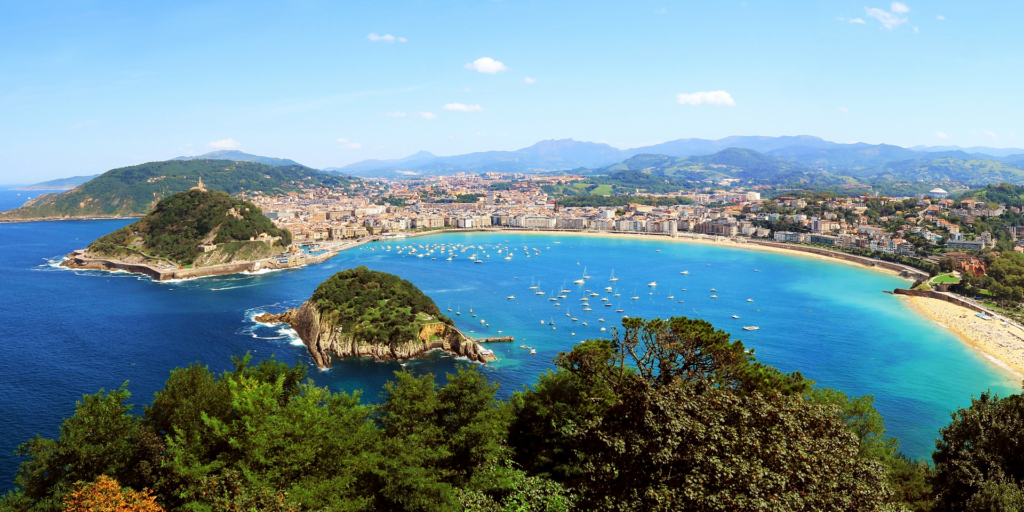Spain, with its diverse landscapes, rich cultural heritage, and vibrant festivals, is a destination that appeals to all types of travelers. Whether you’re drawn to the sunny beaches of the Costa del Sol, the architectural wonders of Barcelona, or the historic charm of Madrid, Spain has something to offer year-round. However, determining the best time to visit Spain depends on several factors, including weather, crowd levels, costs, and the experiences you wish to have. This guide provides a detailed look at the seasons, costs, and key activities to help you decide when to plan your Spanish adventure.
Understanding Spain’s Climate

Spain is a large country with varied climates, influenced by its diverse geography. From the Mediterranean coastline to the mountainous regions, weather conditions can vary significantly.
- Coastal Areas (Mediterranean Climate):
- Regions: Costa del Sol, Costa Brava, and the Balearic Islands.
- Summers (June to August) are hot and dry, with average temperatures ranging from 25°C to 30°C (77°F to 86°F).
- Winters (December to February) are mild, with temperatures around 10°C to 15°C (50°F to 59°F).
- Inland Areas (Continental Climate):
- Regions: Madrid, Toledo, and parts of Andalusia.
- Summers are scorching, often exceeding 35°C (95°F), while winters can be cold, with temperatures dipping to 0°C to 5°C (32°F to 41°F).
- Northern Spain (Oceanic Climate):
- Regions: Basque Country, Galicia, and Asturias.
- The north experiences cooler, wetter summers with temperatures around 20°C to 25°C (68°F to 77°F) and mild winters.
- Canary Islands (Subtropical Climate):
- Known for their year-round mild temperatures, ranging from 18°C to 24°C (64°F to 75°F), making them a popular destination for winter sun.
With such varied climates, it’s essential to consider the region you plan to visit when deciding on the best time to travel.
Keep reading: How to Avoid Tourist Scammers in Spain
Spring (March to May): Best Overall Time

Why Spring is Ideal:
Spring is widely regarded as one of the best times to visit Spain, especially for first-time visitors. The weather is pleasant, and the country comes alive with colorful festivals, blooming landscapes, and vibrant cultural activities.
- Weather:
- In most regions, spring offers comfortable temperatures, ranging from 15°C to 25°C (59°F to 77°F). It’s perfect for outdoor sightseeing without the scorching heat of summer.
- Crowd Levels:
- Tourist numbers are moderate, particularly in March and April, meaning you can explore popular landmarks like the Alhambra in Granada or the Sagrada Família in Barcelona without battling overwhelming crowds.
- Costs:
- Spring is a shoulder season in Spain, meaning prices are relatively affordable. Hotel rates typically range between €70 and €150 per night for a mid-range hotel. Flights to Spain from other European countries or the U.S. tend to be cheaper than during the peak summer months. Expect round-trip airfare to range from €200 to €400 depending on the departure location.
- Festivals and Events:
- Semana Santa (Holy Week), celebrated in late March or early April, is one of the most significant religious festivals in Spain, especially in Andalusia. Cities like Seville and Málaga host grand processions, drawing thousands of visitors.
- Feria de Abril (April Fair) in Seville offers a taste of authentic Spanish culture with flamenco, bullfighting, and traditional Andalusian costumes.
Summer (June to August): Crowded and Expensive

Why Summer Might Be for You:
Summer is peak tourist season in Spain, and it’s when many international travelers flock to the beaches of the Mediterranean coast or the islands of Ibiza and Mallorca. While it’s an excellent time for beach holidays and festivals, summer comes with high prices, large crowds, and extreme heat in some areas.
- Weather:
- Coastal regions, such as Costa del Sol and the Balearic Islands, enjoy hot, sunny weather with temperatures ranging from 28°C to 35°C (82°F to 95°F). Inland cities like Madrid and Seville, however, can be unbearably hot, with temperatures soaring to over 40°C (104°F).
- Crowd Levels:
- Tourist numbers are at their peak, particularly in July and August. Beaches, popular attractions, and hotels are often crowded, and finding a peaceful spot in famous destinations can be challenging.
- Costs:
- Summer is the most expensive time to visit Spain. Hotel rates can skyrocket, especially in beach destinations. A mid-range hotel in Barcelona or Ibiza can cost between €150 and €300 per night. Airfares also tend to be higher, with round-trip tickets from the U.S. or other parts of Europe often ranging between €300 and €600.
- Festivals and Events:
- San Fermín (Running of the Bulls) in Pamplona takes place in July and is one of Spain’s most famous festivals. However, it’s not for the faint-hearted, as the event involves running through the streets alongside charging bulls.
- La Tomatina in Buñol (August) is a quirky and fun festival where thousands of people throw tomatoes at each other in the streets. It’s a unique experience but can be crowded, with attendees paying around €15 for entry.
- Best For:
- If your ideal vacation involves lounging on the beach or partying in Ibiza, summer is perfect. For city exploration and cultural experiences, however, the heat and crowds can make summer less appealing.
Autumn (September to November)

Why Autumn is a Great Time:
Autumn, like spring, is another shoulder season offering milder weather, lower prices, and fewer tourists. It’s a perfect time for those who want to explore Spain’s cities, enjoy local cuisine, or attend harvest festivals.
- Weather:
- September still retains some of the warmth of summer, with temperatures ranging from 20°C to 30°C (68°F to 86°F), making it ideal for visiting beaches without the intense heat of July and August. By October and November, the weather cools down significantly, with temperatures averaging between 15°C and 20°C (59°F to 68°F) in most regions.
- Crowd Levels:
- September marks the end of the high tourist season, and by October, the crowds begin to thin out, offering a more relaxed travel experience.
- Costs:
- Prices begin to drop in September and continue to decrease throughout October and November. You can find mid-range hotels for around €70 to €120 per night, and flights are also more affordable, with round-trip fares often ranging between €150 and €300.
- Festivals and Events:
- La Mercè Festival in Barcelona (September) is the city’s biggest street festival, featuring parades, fireworks, concerts, and the famous “castells” (human towers).
- Wine Harvest Festivals: In regions like La Rioja, September is the time for wine harvest celebrations. Visitors can take part in wine tastings, grape stomping, and vineyard tours.
- Best For:
- Autumn is ideal for food and wine enthusiasts, as it coincides with harvest season. It’s also a great time for cultural exploration, as the cooler weather makes it easier to explore cities like Madrid, Toledo, and Granada.
Winter (December to February)

Why Winter Might Be Your Best Option:
Winter in Spain offers a unique experience, especially for those looking to avoid the tourist crowds and high prices of the summer. While the weather in northern and inland Spain can be cold, the southern regions and the Canary Islands remain mild, making winter an attractive time for sun-seekers and budget travelers.
- Weather:
- In northern regions like the Basque Country and the Pyrenees, temperatures can drop to between 5°C and 10°C (41°F to 50°F), with the possibility of snow in mountainous areas. However, southern Spain and the Canary Islands remain warm, with temperatures ranging from 15°C to 20°C (59°F to 68°F), making them ideal for a winter getaway.
- Crowd Levels:
- Winter is the least crowded time to visit Spain, except during the Christmas and New Year holidays. You’ll have many of the top tourist sites to yourself, and there’s no need to worry about long lines or packed beaches.
- Costs:
- Winter is the most affordable season to visit Spain. Hotel rates are significantly lower, with mid-range hotels costing between €50 and €100 per night in many areas. Flights are also at their cheapest, with round-trip fares often as low as €100 to €250 depending on your location.
- Festivals and Events:
- Christmas Markets: Spain’s cities light up with festive decorations, and Christmas markets pop up in places like Madrid, Barcelona, and Seville. You can find traditional Spanish treats like turrón and polvorones and shop for local handicrafts.
- Three Kings’ Day (January 6) is an important holiday in Spain, celebrated with grand parades and gift-giving.
- Best For:
- Winter is perfect for budget-conscious travelers or those looking to experience Spain’s rich Christmas traditions. If you want a winter escape to a warm destination, the Canary Islands are a great option.
Conclusion: What is the Best Time to Visit Spain?
The best time to visit Spain ultimately depends on what you want from your trip. If you’re seeking a balanced mix of pleasant weather, moderate crowds, and reasonable prices, spring (March to May) and autumn (September to November) are ideal. These shoulder seasons offer the best of both worlds: comfortable temperatures and a wealth of cultural experiences without the intensity of the summer crowds.
For beach lovers and festival-goers, summer (June to August) is the best time to soak up the sun and immerse yourself in Spain’s vibrant party scene, though you’ll need to prepare for higher prices and large crowds. Winter (December to February), on the other hand, is perfect for budget travelers and those looking for mild weather in southern Spain or the Canary Islands.
No matter when you decide to visit, Spain’s rich history, diverse landscapes, and welcoming culture make it a destination worth exploring at any time of the year.
Read more: 10 Days in Spain: A Full Detailed Planing











